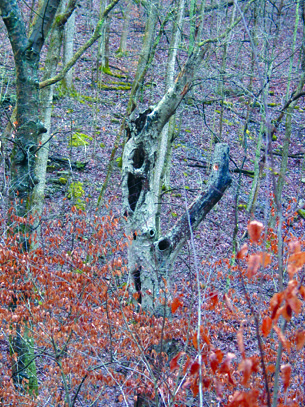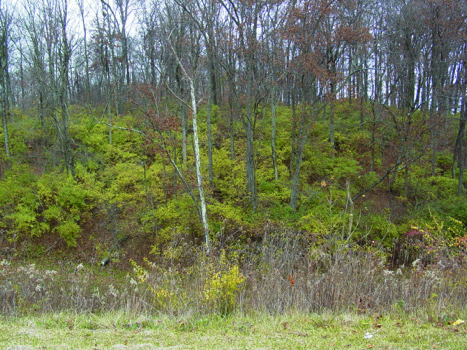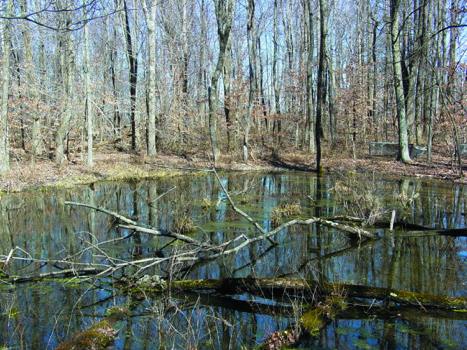A Few Beneficial Forest Management Practices (BFMPs) for Bats
Most people might be surprised to learn that about 20 percent of all mammals in the world are bats (over 1,300 bat species). In the eastern United States, most bats are dependent upon forests for roosting habitat, foraging habitat and reproduction. Despite their success in spreading out across the globe, bats are in trouble locally. Over the past decade, white-nose syndrome (WNS), an introduced fungal disease, has killed millions of bats across the eastern United States and Canada including thousands of bats in Indiana. While the long-term effects of the severe WNS-related population declines remain uncertain, scientists are concerned about potentional reductions the roles bats play in insect and pest reduction, as well as nutrient cycling.
What can you do to help? Woodland owners can do several things on their property to maintain and improve habitat for bats and give them a fighting chance. While no individual property is the answer, collectively private woodland owners can make a big difference especially since most of the woods in Indiana are owned by private individuals. The BFMPs outlined below can be performed in almost any woodlot or forest. Together, they will help bats in your area to meet their shelter, food and water needs while benefiting other species of wildlife that call your woodlands home.
• Shelter/Snag management - When bats emerge from hibernation each spring, several different species seek shelter for themselves and their pups by roosting under loose pieces of bark and in hollows on standing dead and dying trees (i.e., snags) throughout the summer and into early fall. In addition to snags, live trees with naturally exfoliating bark (e.g., shagbark and shellbark hickory) provide important roosting habitat for bat as do trees with splits and hollows. Larger snags (>9” dbh) that receive a lot of direct sunlight tend to form the most valuable roost sites for maternity colonies (i.e., large groups of female bats and their pups), which collectively may use dozens of different trees over the course of a summer. For these reasons, woodland owners can benefit bats by leaving high-quality snags (i.e., those most likely to be used by bats) standing for as long as possible or until most of their bark has fallen off. If a snag(s) needs to be felled for firewood or safety reasons, the best time to avoid potential injury to roosting bats would be during the winter months (e.g., Oct. – Mar.) when bats are hibernating in caves and mines. Otherwise, try to avoid felling snags and other potential roost trees during June and July when the mother bats are giving birth to their pups, which can’t fly until a month old.
• Food/Non-native invasive species (NNIS) Management - There are many good reasons to control NNIS plants (and insects) in your woods and removing them to benefit bats is just one more. All of the bats in Indiana eat insects as they fly above and below the canopy of forests and woodlands at night. Left uncontrolled, some NNIS plants, such as bush honeysuckle (Lonicera spp.), can quickly clutter the understory of a woods, suppress native tree regeneration and physically reduce the amount of unobstructed subcanopy space where many bats prefer to forage. Removing NNIS can benefit bats by providing more open/uncluttered foraging habitat and increasing the diversity and abundance of insects (i.e., bat food).
 • Water – In addition to food and shelter, bats need access to water. In areas lacking nearby streams or ponds (e.g., dry ridgetops), woodland owners can benefit bats and other wildlife by creating a water source such as a pond or ephemeral wetland (see Biebighauser 2003). A small pond can provide a drinking source of water for bats (they drink by skimming the surface of the water while flying) and can benefit them by increasing insect (prey) availability as well. Even a relatively small road rut along a woodland road can provide a source of drinking water for bats.
• Water – In addition to food and shelter, bats need access to water. In areas lacking nearby streams or ponds (e.g., dry ridgetops), woodland owners can benefit bats and other wildlife by creating a water source such as a pond or ephemeral wetland (see Biebighauser 2003). A small pond can provide a drinking source of water for bats (they drink by skimming the surface of the water while flying) and can benefit them by increasing insect (prey) availability as well. Even a relatively small road rut along a woodland road can provide a source of drinking water for bats.
For additional information…
Beneficial Forest Management Practices for WNS-affected Bats: Voluntary Guidance for Land Managers and Woodland Owners in the Eastern United States.
Biebighauser, T.R. 2003. A Guide to Creating Vernal Ponds, USDA Forest Service. 33pp. Accessed on 12/11/2018 at http://herpcenter.ipfw.edu/outreach/vernalponds/vernalpondguide.pdf
White-Nose Syndrome − https://www.whitenosesyndrome.org
Andy King is an endangered species biologist in the U.S. Fish and Wildlife Service’s Indiana Ecological Services Field Office in Bloomington, Indiana. He began working with endangered species over 25 years ago as an environmental consultant conducting and subsequently overseeing field surveys and radio-telemetry studies of federally endangered bats across the eastern U.S.
